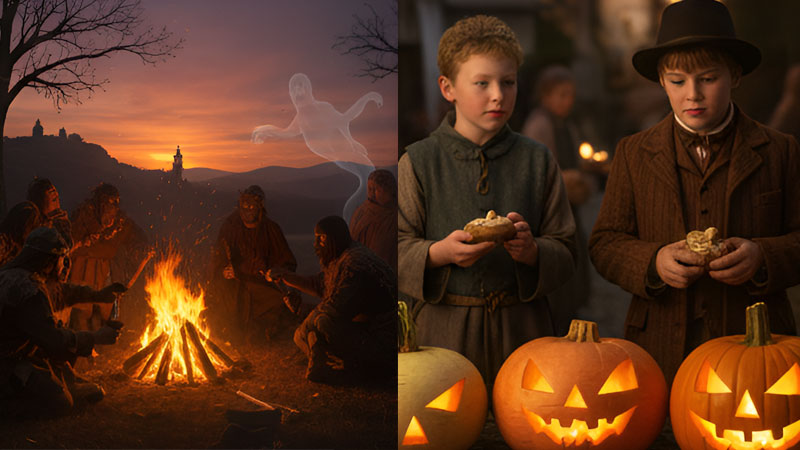Halloween, the spookiest night of the year, has a long and mysterious history rooted in ancient Celtic and European traditions. What began as the Gaelic festival of Samhain — marking the end of the harvest season — evolved over centuries into a beloved celebration filled with costumes, pumpkins, and trick-or-treating. Let’s uncover how Halloween came to be what it is today.
Halloween is an annual celebration. But do you know how it came into existence? Like all other celebrations, Halloween too has its history. Halloween history is one of religious traditions, sacrifices and folklore. And it is, indeed, a fascinating one.
History of Halloween, like that of any other festival, is inspired through traditions that have come about through ages from one generation to another. We follow them mostly as did our dads and grandpas but it must be agreed that, with time, much of the originality of the tradition has got distorted with newer additions and alterations. So much so, that it is now almost impossible to know the true origin of the tradition. But what seems to be the most authentic reasons are discussed here.

The word "Halloween" actually has its origins in the Catholic Church. The term is shortened from All-hallow-even, or "All Hallows' Day", which is now known as "All Saints' Day". It was a Catholic day of observance in various northern European Pagan traditions. Roman Catholics, Episcopalians and Lutherians used to observe "All Hallows Day" to honor all Saints in heaven, known or unknown. The holiday was called Samhain (sow-en), the Celtic New Year.
Many European cultural traditions, particularly the Celtic cultures, hold that Halloween is one of the liminal times of the year when spirits can make contact with the physical world, and when magic is most potent (according to, for example, Catalan mythology about witches and Irish tales of the Sídhe).
The Romans observed the holiday of Feralia, intended to give rest and peace to the departed. Participants made sacrifices in honor of the dead, offered up prayers for them, and made oblations to them. The festival was celebrated on February 21, the end of the Roman year.
The modern holiday of Halloween has its origins in the ancient Gaelic festival known as Samhain. The Festival of Samhain is a celebration of the end of the harvest season in Gaelic culture, and is erroneously regarded as 'The Celtic New Year'. Traditionally, the festival was a time used by the ancient pagans to take stock of supplies and slaughter livestock for winter stores. The Ancient Gaels believed that on October 31, the boundaries between the worlds of the living and the dead overlapped and the deceased would come back to life and cause havoc such as sickness or damaged crops.
The festivals would frequently involve bonfires, where the bones of slaughtered livestock were thrown. Costumes and masks were also worn at the festivals in an attempt to mimic the evil spirits or placate them. When the Romans occupied Celtic territory, they incorporated the Celtic practices into the festivals. In the first century AD, Samhain was assimilated into celebrations of some of the other Roman traditions that took place in October, such as Feralia, their day to honor Pomona, the Roman goddess of fruit and trees. The symbol of Pomona is the apple, which might explain the origin of our modern tradition of bobbing for apples on Halloween.
The custom of Halloween was brought to America in the 1840s by Irish immigrants fleeing their country's potato famine. At that time, the favorite pranks in New England included tipping over outhouses and unhinging fence gates.
The custom of trick-or-treating is thought to have originated not with the Irish Celts, but with a ninth-century European custom called souling. On November 2, All Souls Day, early Christians would walk from village to village begging for "soul cakes," made out of square pieces of bread with currants. The more soul cakes the beggars would receive, the more prayers they would promise to say on behalf of the dead relatives of the donors. At the time, it was believed that the dead remained in limbo for a time after death, and that prayer, even by strangers, could expedite a soul's passage to heaven.
The Jack-o-lantern custom probably comes from Irish folklore. As the tale is told, a man named Jack, who was notorious as a drunkard and trickster, tricked Satan into climbing a tree. Jack then carved an image of a cross in the tree's trunk, trapping the devil up the tree. Jack made a deal with the devil that, if he would never tempt him again, he would promise to let him down the tree.
According to the folk tale, after Jack died, he was denied entrance to Heaven because of his evil ways, but he was also denied access to Hell because he had tricked the devil. Instead, the devil gave him a single ember to light his way through the frigid darkness. The ember was placed inside a hollowed-out turnip to keep it glowing longer.
The Irish used turnips as their "Jack's lanterns" originally. But when the immigrants came to America, they found that pumpkins were far more plentiful than turnips. So the Jack-O-Lantern in America was a hollowed-out pumpkin, lit with an ember.
So, although some cults may have adopted Halloween as their favorite "holiday," the day itself did not grow out of evil practices. It grew out of the rituals of Celts celebrating a new year, and out of Medieval prayer rituals of Europeans.
The thrust of the practices also changed over time to become more ritualized. As belief in spirit possession waned, the practice of dressing up like hobgoblins, ghosts, and witches took on a more ceremonial role.
And today, even many churches have Halloween parties or pumpkin carving events for the kids. After all, the day itself is only as evil as one cares to make it.
Try out the other sections